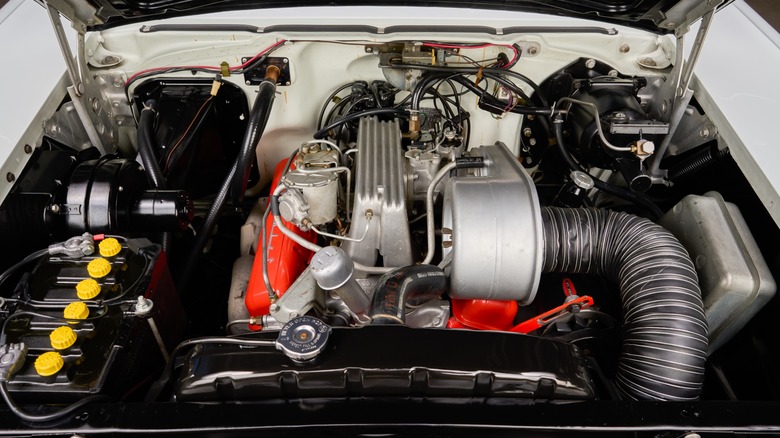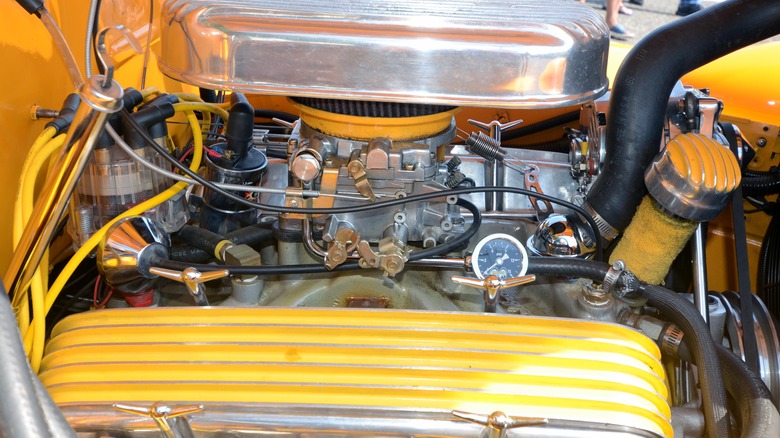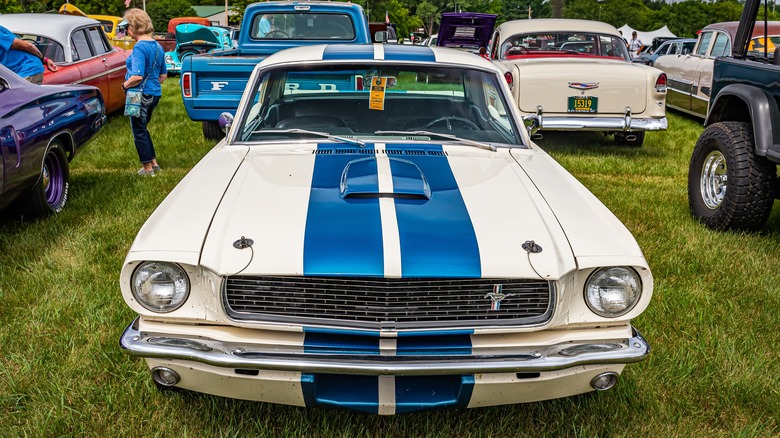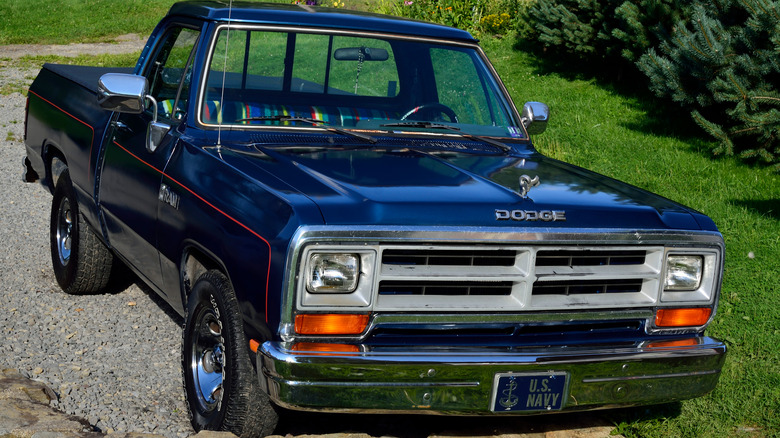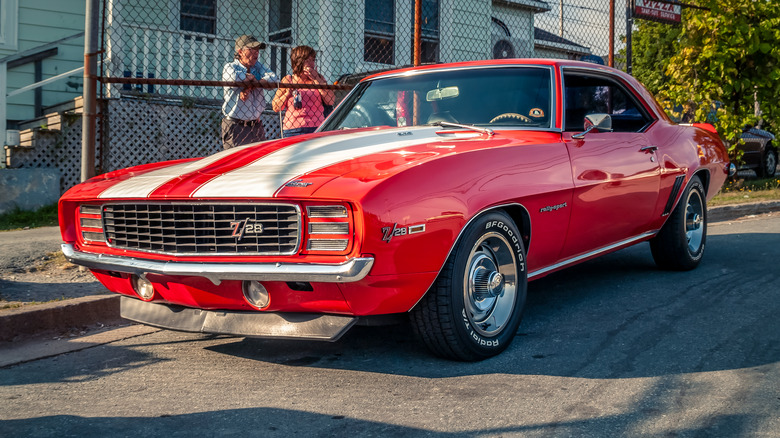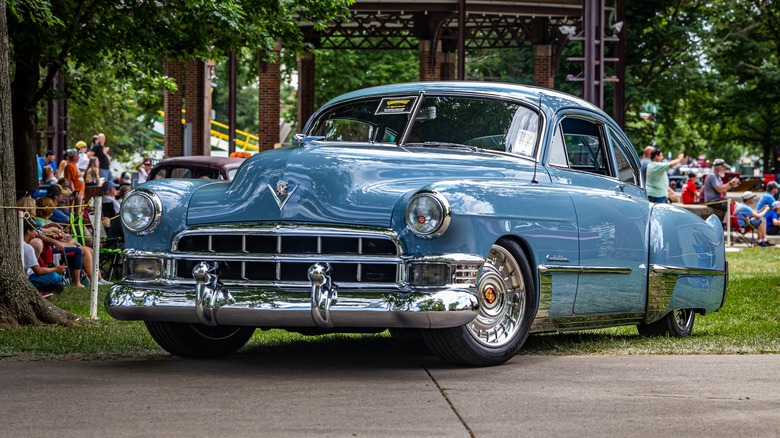5 Small Block Engines That Pack Way More Punch Than Expected
Automotive engine technology has advanced many miles since Carl Benz put a one-cylinder gas motor in the Patent Motorwagen, creating the first car ever in the late 19th Century. A couple of decades later, Henry Ford adapted Nicolaus Otto's four-stroke design for the Model T's engine, and the auto industry flourished as manufacturers began developing more powerful and more reliable motors. Although inline six-cylinder engines run smoothly and are some of the most reliable ever made, the motoring public's thirst for speed made V8 engines the go-to from the mid-1950s through the muscle car era of the '60s and early '70s.
While there are plenty of big-block V8s that pack a wallop, automotive engineers have spent countless hours trying to eke out as much power as possible from smaller engines. The weight and size savings of small-block engines allows automakers to put them in lighter and more agile cars. Since Chevrolet built its first small-block V8 in the early 1950s, the industry has cranked out a handful such engines that put out a remarkable amount of power relative to their size.
1957 Chevy 283
Ed Cole began at General Motors in 1930 and by 1952 had been named Chevy's chief engineer. He was instrumental in developing the small-block V8 and the Corvette. The success of both those endeavors led to him being named President and CEO of GM in 1967. The cars from 1957 are regarded as a peak for Chevrolet, with that year's Bel Air now known simply as the "57 Chevy." That year, GM's 283 cubic inch V8 could produce one horsepower for each cubic inch of displacement, a long sought-after milestone.
Chevy's engineers bored older 265 inch V8's cylinders out from 3.75 inches to 3.875 inches to make the extra displacement, and boosted the compression ratio to 10:1. A version of the 283 with two four-barrel carburetors made a more modest 270 horsepower. The '57 Bel Air sedan and Corvette were the only models to get the more powerful fuel-injected engine.
Ford K-code 289
The Mustang debuted in Apri 1964 with a 170 cubic inch inline 6 engine, although two V8s were on the option sheet. From two months after the Mustang's debut through the 1967 model year, buyers could choose the K-code high-performance package for an additional $442.60 (about $4,500 in today's money). That extra letter in a Mustang's VIN got you a 289 cubic inch V8 capable of 271 horsepower thanks to heavy-duty rods and aluminum pistons, a cast-iron crankshaft, and a dual exhaust system. While the stock Hi-Po 289 didn't make the threshold of one horsepower per cubic inch, the modified version in the Shelby GT-350 got there with horses to spare.
The GT-350's engine upgrades included piston rings with a tighter gap, polished cylinders, and milled heads. These tweaks improved the 289's output to 306 horsepower for the 350 GT and 350 horsepower for the racing-spec 350 GT-R. The higher number for the GT-R was achieved by using larger valves and honing the ports to allow for a freer flow of fuel and exhaust.
Mopar 318
Chrysler's 360 cubic inch V8 gets a lot of attention for its legendary performance and reliability, but its older and smaller brother, the 318, deserves some kudos as well. The 318 and 278 launched the LA-series Mopar small block line in 1964 and were soon followed by larger 340 and 360 cubic inch variants. The LA series was an evolution from the previous A series, with lighter castings and wedge-shaped heads replacing the older polyspherical ones.
The 318 was used from 1967 through 2002, and could be found in a wide range of Chrysler-branded vehicles from the Plymouth Valiant and Dodge Dart to later Dodge Ram pickup trucks. Even though the late '60s carbureted version of the 318 made 230 horsepower, the 318 and 360 got throttle-body fuel injection in 1988 and multi-port injection along with a host of other upgrades four years later. The 318 was also used in 1993-98 Jeep Grand Cherokees, and those vintages rank among the best years for that venerable SUV.
Chevy DZ 302
Ford's 302 cubic inch (5.0 liter) engine was used from 1968 through 1995, but in its earlier years, it couldn't compete with Chevy's identically sized performance engine. The Chevrolet DZ 302 was first used in the 1967 Camaro Z/28, borrowing its block from the 350 and crankshaft from the 283. Ford and Chevy's 302-inch V8s shared a relatively unique oversquare layout with a bore of four inches and a stroke of three inches, which allowed these engines to rev higher than bigger V8s without failing. This durability helped Chevy 302-powered Z/28s win the Trans Am series title in 1968 and '69. The stock version of the 1969 Z/28 was officially rated at 290 horsepower but tested at around 100 more than that, while the Mustang's base 302 only produced 220 horsepower.
Ford kept its 302 V8 for more than a quarter-century and distributed it across much of its product line, including the Fairlane, Ranchero, and Crown Victoria. Chevy took the opposite approach for its engine of the same size, reserving it solely for the three-year run of the first-generation Camaro Z/28.
Cadillac 331
You'll have to travel back in time to 1949 to fully appreciate the next engine on our list, but at least you'll be able to pick up a gorgeous Cadillac for about $3,000 while you're there. The Series 62 club coupe shown above cost just $2,900, and the convertible was $500 more. They were both powered by Cadillac's new 331 cubic inch V8, which had vertically tapered combustion chambers like the Dodge Max Wedge muscle car that came along more than two decades later.
The Cadillac 331 was the brand's first overhead valve engine and replaced a 346 cubic inch Flathead. The 331's output of 160 horsepower seems low by modern standards, but it was the most powerful engine available at the time and was strong enough to earn the 1949 Cadillac the inaugural Motor Trend Car of the Year Award. Cadillac's 331-inch V8 helped usher in the large bore, short stroke design of the Chevy and Ford 302 V8s of the late '60s and helped Briggs Cunningham pilot a Coupe De Ville to a 10th place finish in the 1950 24 Hours of LeMans.
